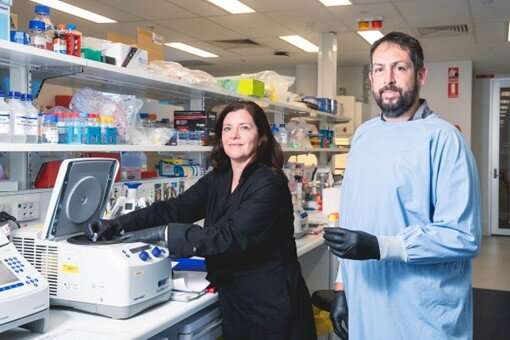This article has been reviewed according to Science X's editorial process and policies. Editors have highlighted the following attributes while ensuring the content's credibility:
fact-checked
peer-reviewed publication
trusted source
proofread
New research discovers new cause of cancer coming from inside us

Australian cancer researchers have made an important new connection between a person's cancer risk and the functions of circular RNAs, a recently discovered family of genetic fragments present within our cells.
A new Flinders University-led study published in Cancer Cell, finds that specific circular RNAs within many of us can stick to the DNA in our cells and cause DNA mutations which result in cancer.
"While environmental and genetic factors have long been believed the major contributors to cancer, this revolutionary finding—which we call 'ER3D' (from endogenous RNA directed DNA damage)—ushers in an entirely new area of medical and molecular biology research," says Flinders University Professor Simon Conn, who leads the Circular RNAs in Cancer Laboratory at the Flinders Health and Medical Research Institute.
"This is the first example of a genetic molecule present within many of us which has the capacity to mutate our very own DNA and drive cancer from inside."
"This opens the door to use these molecules as new therapeutic targets and markers of disease at a very early stage, when the likelihood of curing cancers is much higher."
The research compared the neonatal blood tests or Guthrie cards of babies who went on to develop acute leukemia as infants with children without any blood disorders. This found that one specific circular RNA was present at much higher levels at birth, prior to onset of the symptoms of leukemia.
The findings suggest it is the abundance of the circular RNA molecules within certain individuals' cells which is a major determinant for why they develop these specific cancer-causing genes or oncogenes and other do not.
"Circular RNAs can bind to DNA at many different locations across a range of cells. By binding to the DNA at specific sites, these circular RNAs cause a number of changes culminating in the breakage of the DNA which the cell must repair in order to survive," says Professor Conn."
"This repair is not always perfect and this can result in small mutations, like a misspelled word within a book, or worse, very, very large and devastating mutations."
"With the circular RNAs also able to alter the physical location of the broken DNA within the cell nucleus, two distinct regions of the DNA can be stuck together during the repair process—like the ripping of two different books and sticking them together."
Lead author Dr. Vanessa Conn says multiple circular RNAs appear to act in partnership causing breaks at multiple sites in the DNA.
"This process, called chromosomal translocation, is a major problem for the cell as it results in gene fusions which can actually convert the cell from a normal cell into a cancerous cell," she says.
"This was demonstrated in two different cell types and it was found that this drove the rapid onset of aggressive leukemia."
The gene fusions arising from the action of these circular RNAs are at well-known "hotspots" of mutation in the blood cancer leukemia. This is an important consideration in Australia which has the highest incidence of leukemia in the world, with around 35,000 Australians currently living with this disease.
These gene fusions have been used by doctors around the world for many years in guiding treatment options as they are known to worsen the prognosis for the patient who carries them, the researchers say.
However, until now it was unknown how these mutations arose, even though more than 100 known fusions were found in patients.
"Not surprisingly, it is not only leukemia where the process of ER3D occurs," says Dr. Conn.
"We now have evidence that ER3D is not restricted to leukemia but to other cancers and human diseases," she says.
The Flinders University research team is continuing the study to investigate circular RNAs' role in cancer and other diseases.
The article, "Circular RNAs drive oncogenic chromosomal translocations within the MLL recombinome in leukemia" has been published in Cancer Cell.
More information: Simon J. Conn, Circular RNAs drive oncogenic chromosomal translocations within the MLL recombinome in leukemia, Cancer Cell (2023). DOI: 10.1016/j.ccell.2023.05.002. www.cell.com/cancer-cell/fullt … 1535-6108(23)00169-1

















